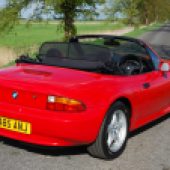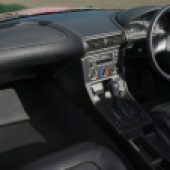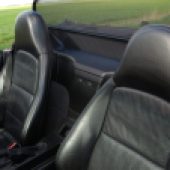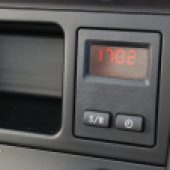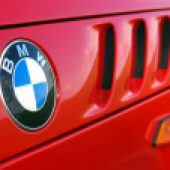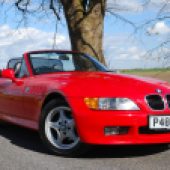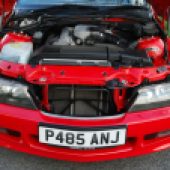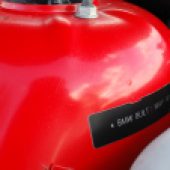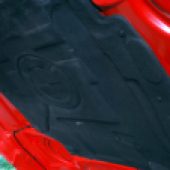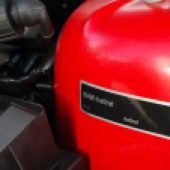The BMW Z3 was the Bavarian outfit’s contribution to the back-to-basics roadster revolution of the late 90s. Here’s how to buy one
Words: Andrew Everett
When the MGB left production in 1980 it had been in production for 18 years and was already touted as a classic. It’s now over 25 years since the launch of the BMW Z3, yet it’s a car that’s still only just on the cusp on being a classic. With values for good examples on the rise and its contemporaries already on the modern-classic rise, we reckon now is the Z3’s time.
The previous Z1 from 1989 had been a technological marvel, introducing the all new Z axle and composite construction, but the BMW Z3 was designed to be built cheaply in volume and the floorpan, suspension and running gear were shared with the 1994 318Ti Compact complete with its old style semi-trailing arm rear suspension, revised from the previous-generation E30 3 Series but basically the same. This was lighter and cheaper to make and it could be tuned to give very good results as the original M3 had proved. It also made the difference between the Z3 having a small boot or none at all.
The Z3 was built at the Spartanburg, South Carolina plant starting in September 1995. Previewed in the first Pierce Brosnan James Bond film Goldeneye that November, the Z3 was launched shortly after with a huge waiting list – and when the Z3 was launched in the UK in July 1996, supply was short and cars were attracting a serious premium.
The UK-market BMW Z3 was powered by the new M44 1.9-litre 16-valve engine giving 140bhp, this being a revised version of the 16-valve 1.8-litre M42 twin cam that had been fitted to 318iS cars since 1989. Europe had the base-model 1.8-litre single-cam model. A five-speed Getrag gearbox from the 318iS with a snappy new short shift lever or a four-speed automatic drove the rear wheels, while the BMW Z3 suspension was a carbon copy of the 318Ti Compact, spruced up with a new quick ratio steering rack with just 2.7 turns lock to lock, plus the front chassis brace from the 3 Series convertible. The brakes were discs front and rear with ABS and ASC traction control.
The body was a tub onto which the outer sills and wings were bolted and the hood was a manual affair with a power option. In 1997, the 2.8 arrived to counter any criticism of the Z3 being a bit slow. The six-cylinder 193 bhp 2.8 added vented front brakes and a wider rear track as well as fatter 16-inch wheels (17s were an option) with wider rear wings.
The suspension was uprated in the spring and damper department as well as revised anti-roll bars whilst a twin pipe exhaust added the required manliness. The M52 2.8 single VANOS (BMW’s name for variable inlet valve timing) straight six engine powered the rear wheels via a beefy ZF five-speed gearbox and a ZF limited-slip differential of the old clutch-plate type with 25% lock up. The 2.8 hit 60 mph in 6.7 seconds, got to 100 mph in 17.5 seconds and would do a very brisk 14.8 second quarter mile.
The BMW Z3 was facelifted in 1999 and whilst it seemed good at the time, opinions differ today on which is the better looking car. The 2.8-style wide body was now standardised on all Z3s while the tail lights, bootlid and rear bumper were all restyled as was the front bumper.
Inside, a new centre console was fitted and new body colours were added to join new style wheels. Engine wise, the M44 engine had already been discontinued elsewhere (the E36 was leaving production) so it was replaced by both an entry level Z3 1.8 using the 1895 cc single-cam M43TU with 118 bhp and also a 2.0 with the 1990cc straight-six M52TU giving 150 bhp. Both sixes had double VANOS with the 2.8 now being fitted with the new Torsen (torque sensing) limited-slip diff. In line with BMW engine changes in late 2000, the 2.8 and 2.0 were both replaced by new M54 2.2 and 3.0 cars, the 2.2 with 170 bhp and the 3.0 boasting an impressive 231 bhp. The M54 units were basically revised M52TU engines but with a fully electronic ‘fly by wire’ throttle and small exhaust manifold catalytic converters to join the main one under the car.
The Z3 was discontinued in June 2002, replaced a few months later by the BMW Z4. The all new Z4 took nothing from the Z3 apart from the 2.2 and 3.0 engines and it was far more sophisticated and expensive with its Z axle rear suspension but it never sold quite as well as the Z3 even though it drove a lot better.
Body and interior
The BMW Z3 doesn’t suffer from serious rot like an MX-5 can and they are normally solid where it counts even if the wings and outer sill panels are in a state – these are bolt on panels as are the front and rear wings. Good original panels are rare because many BMW Z3s will be showing rust in these areas. Sill and wing replacement is easy enough but new panels are pricey from BMW so weigh up the restoration costs when buying. Rot in the main shell is pretty rare with the main spot being at the front of the floor where the sill bolts on.
The majority of BMW Z3 hoods are easily operated manuals. The hydraulic power hoods are reliable enough but they are no faster. The front hood seals can need treating with something like Vaseline and the latches can wear out, requiring some adjustment if there’s a water leak but a knackered plastic rear screen is a job for a professional as they don’t ‘just zip in’ no matter what the seller says.
Complete used hoods are available and to replace one is not too bad a job to fit with two of you but power hoods are more tricky although they can be converted to manual.
The BMW Z3 used plastic headlight lenses that go horrible and milky with age but they can be rubbed down with wet-and-dry and soapy water before being polished with a rotary polishing mop and cutting paste. Door mirrors break for fun. The alloy ‘monkey metal’ pivot corrodes and it just breaks when the mirror housing gets knocked or you try to fold it in. Good used mirrors cost £100 upwards but you can buy plastic replacements that cost about the same. On these you’ll need to prime and paint the pivot before you transfer the original outer casing, wiring and glass over.
Central locking problems are due to faulty door locks or more often alarms – even the original dealer-fit BMW alarm is best removed and binned. The third brake light in the bootlid can fall to bits but new red lenses are available from BMW and are easy to fit. The dreaded BMW Z3 ‘seat rock’ is due to worn runners but it’s simply and cheaply fixed with new blocks.
The air conditioning system is derived from the Compact and whilst it’s not massively efficient, there isn’t much interior space to cool down. If it doesn’t work, it’s worth having it fixed because parts like a new condenser or a used compressor are surprisingly cheap.
The standard cloth seats are pretty grim but are easily replaced with a second hand leather trim but make sure the airbag sensor connectors are the same as they can differ around 1998/9. The steering lock can suffer from the infamous ‘key spin’ and a quick fix can be done with a hole drilled in the outer casing underneath and a short correctly positioned screw to lock the barrel in place.

Engine and transmission
There are four engine types in the Z3, the 1.9-litre twin-cam M44, the 1.9 single-cam M43, the six-cylinder 24-valve M52TU in 2.0 and 2.8 forms and the similar M54 six in 2.2 and 3.0 capacities.
Starting with the M44, this was the original engine and it’s a very good one with regular maintenance. The head gasket can fail on units that have been run low on coolant but it’s fairly simple to replace. The exhaust manifold can blow from the pipe to flange joint on the head but it can be removed and welded. Water pumps can fail as well but they’re not too challenging to replace.
The single-cam version (called the Z3 1.8) is much the same but head gaskets are quite a common failure although it’s a feasible DIY repair. Running faults can be due to crank and cam sensors as well and the electronic idle valve on the inlet manifold. On both fours the oil filter housing gasket can leak. The M43 has a plastic coolant elbow on the back of the head and both fours have one on the side of the block which will need replacing by now as they go brittle and crack. Timing chains are excellent and I’ve not seen one break.
The M52 six is a great engine even if the 2.0 version is little faster than the 16-valve M44. Early 2.8s before March 1998 can still have either the US spec iron block engine (better) or the alloy block with Nikasil bore coating. These were well known for the Nikasil (silicon nickel) flaking off and causing gradual compression loss. Many were replaced under warranty so look for a rusty steel tab and a 10mm bolt under the starter motor as confirmation.
The M52TU arrived in September 1998 and featured the steel bore liners introduced in March 1998 as well as double VANOS and an all new engine management system. Over time the seals in the VANOS unit can wear out leading to poor performance and most will need doing by now. Common oil leaks are from the cam cover gasket and the oil filter housing gasket.
The M54 from late 2000 was very similar but it used an electronic throttle and thinner piston rings for less friction. That means the engine can use quite a lot of oil with the 2.2 often being quite a drinker and smoker – the 3.0 is better. All sixes use a crankcase ventilation system of plastic pipes which will all need replacing by now if original. The M52 oil leaks apply but they’re quite simple to rectify. Water pumps can fail but they are easy and cheap to replace.
However, an overheated six with head gasket issues is scrap – forget trying to repair one, just replace the engine. The threads on the alloy block for the head (stretch) bolts weaken and they will pull out on reassembly. By the time you’ve messed around with helicoils and failed, you could have just fitted another engine.
All Z3 1.8, 1.9 and 2.0 cars use the Getrag 250G five-speed which is very tough and long-lasting, plus it’s very cheap and easy to replace. The four-speed GM automatic gearbox is reliable but it’s not very good, never seeming to be in the right gear although OK in town. These require a periodical oil and filter screen change whilst on manual gearbox cars replacing the gear linkage bushes is a cheap but fiddly way to transform a sloppy lever. Auto gearbox problems can be caused by a faulty ABS or engine sensor.
The bigger engine cars use either a ZF 310/320Z gearbox or a five-speed ZF auto and the same applies with manuals: they rarely go wrong. The diffs are long lasting although the small case units on all but the 2.8 and 3.0 can get a bit whiney in old age at high mileage but they are cheap and plentiful used and easy enough to replace, as are the driveshafts.
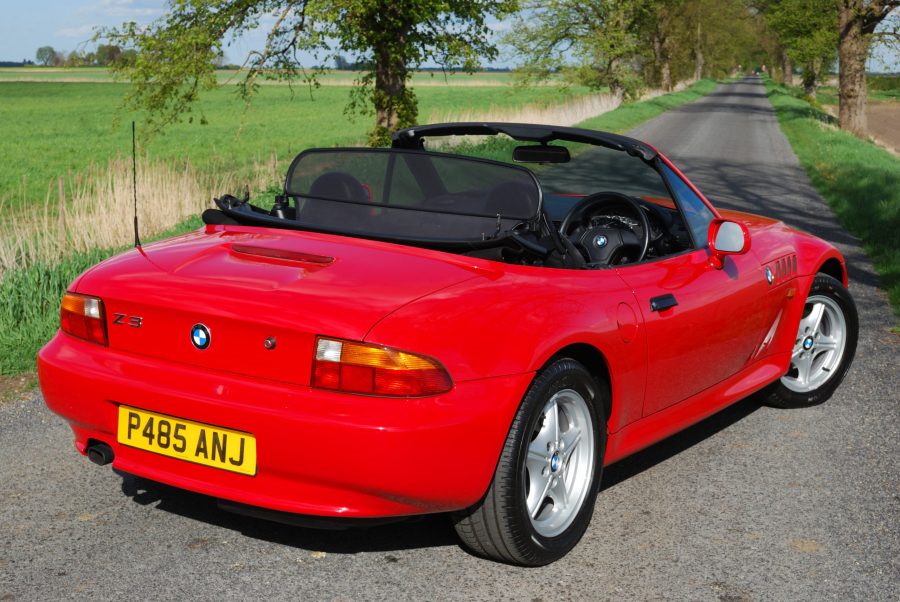
Suspension, steering and brakes
The Z3 suspension is tough and not bad to work on. The common front end weak points are tired front dampers. Rusty front wishbones are ideally replaced by complete new ones and without the special tools you can forget about replacing balljoints. Rear axle outer beam bushes are a common issue and replacing them is a garage job unless you have the expensive tool to remove and replace them. Watch out for rusty trailing arms as well, now becoming a common problem on cars that are a bit ropey underneath.
The steering rack is Z3 specific with 2.7 turns lock to lock. Good used ones are £100 upwards but the ‘purple tag’ E46 3 Series rack is quite similar and a straight swap at around £50 used.
The BMW Z3 braking system holds no fears. Six-pot cars have vented discs, solids on the fours. Rusty brake pipes are common as are dicky ABS sensors but they’re very cheap to buy aftermarket. Even if the ABS unit fails, there are plenty of good used ones as they were often shared with the 3-Series. The handbrake is notoriously bad unless it’s adjusted absolutely correctly and we’d recommend using genuine BMW shoes.
BMW Z3: our verdict
The BMW Z3 was never regarded as a competitive driver’s car, with the 1.9-litre model falling behind the Mazda MX-5 dynamically, and the 2.8- or 3.0-litre models falling short of the Porsche Boxster where it counted. However, the Z3 is still entertaining to drive and certainly has a slightly vintage feel to its ride and handling that makes the four-pot cars an MGB alternative – and the more powerful six-cylinder could be construed as a cut-price Austin-Healey 3000. Elsewhere, the Z3 is very practical, generally reliable and the parts supply is excellent, as much of the car was shared with the contemporary 3 Series.
There is no shortage of Z3s so it’s a buyer’s market. A good 1.9-litre car is considerably cheaper than an equivalent Mazda, but prices rise for lower mileage cars – at which point you should ask yourself whether the money is better spent on a six-cylinder car. The 2.0 and 2.2 cars don’t perform a lot better than the original M44 1.9 did whilst using rather more fuel but they are newer of course.
We think a mint late and low mileage 2.2 is a good car, but the 2.8 goes so much better and uses no more fuel – they and the 3.0 are the future Z3 classics in demand. BMW Z3s in funky colours like Fiji Green, Palmetto Green and Dakar Yellow will always be worth more.
BMW Z3 timeline
1995
BMW Z3 previewed in James Bond, Goldeneye movie. Production starts in America in November, initially only offering the 1.8-litre M43B18 engine
1997
Z3 2.8 launched, powered by 193bhp M52B28 engine. Z3M Roadster and Coupe also introduced, powered by 3.2-litre S50B32 from E36 M3, boasting 321bhp
1998
Z3 2.2 launched, sporting 2494cc six-cylinder engine
1999
Z3 range facelifted with 2.8’s wide-body standardised, rear lights, bootlid and both bumpers revised. Z3 1.9 now has 117bhp M43B19, Z3 2.0 offered with 150bhp 2.0-litre M52B20, Z3 2.2 launched with 170bhp M52B22. Range-topping Z3 3.0 launched with 3.0-litre, 228bhp M54B30
2001
Z3M Coupe and Roadster upgraded to S54B32 engine
2002
BMW Z3 production ends in June, with 297,000 sold in total. Z4 replacement launches in 2003
BMW Z3 alternatives
Porsche Boxster
The Z3 is a great sports car, but if you fancy a six-pot roadster, you could also have a mid-engine Porsche. The Boxster out-handles and outperforms the Z3 and feels more special, but buying and maintaining the Porsche will be pricier

Mazda MX-5 Mk2
If you’re looking at a four-cylinder Z3, a tidy Mk2 MX-5 can be bought for similar or less money. Not as prestigious, granted, but the Mazda offers possibly sweeter handling, far better parts and club support and the option of the punchy VVT model




